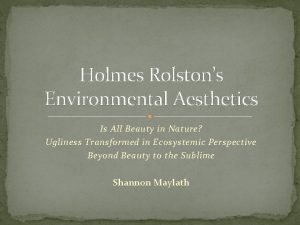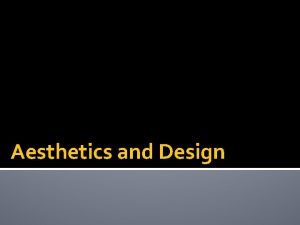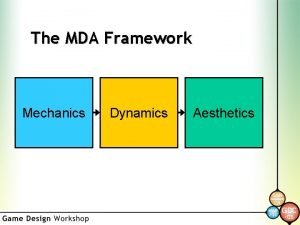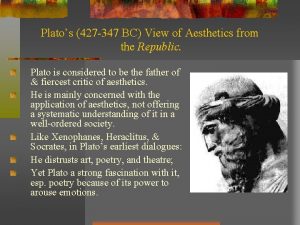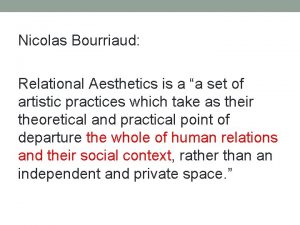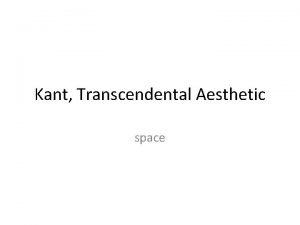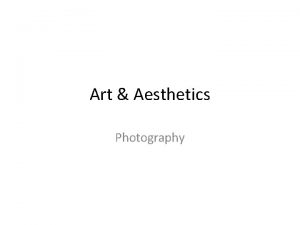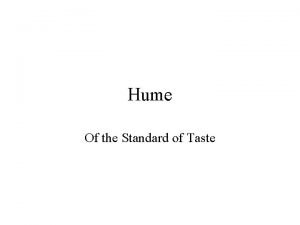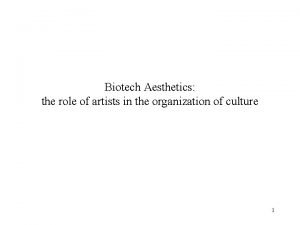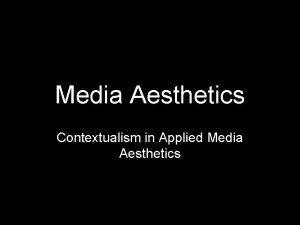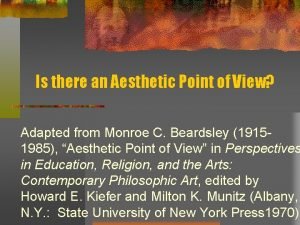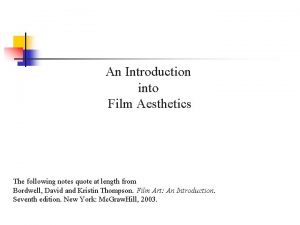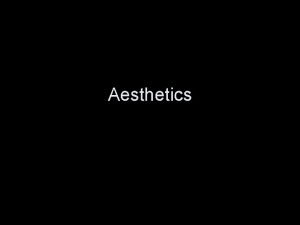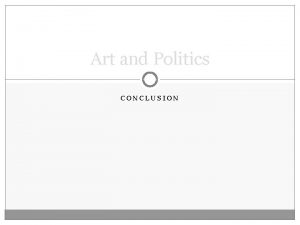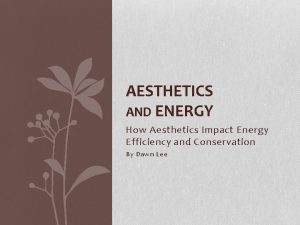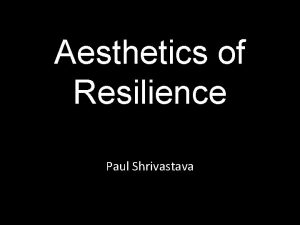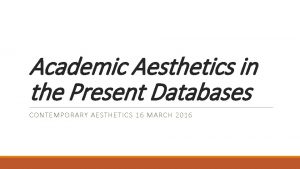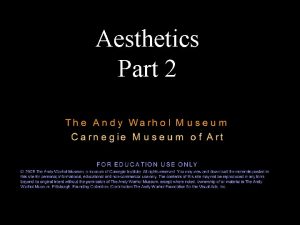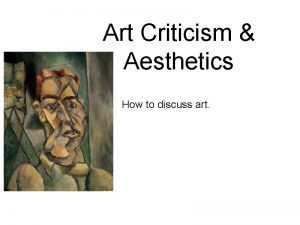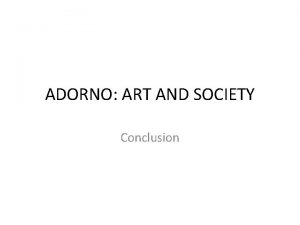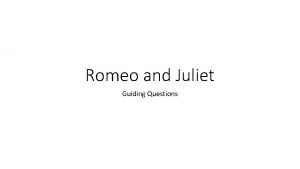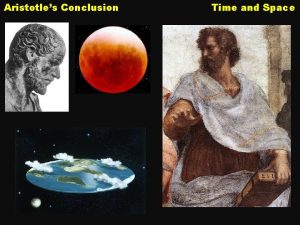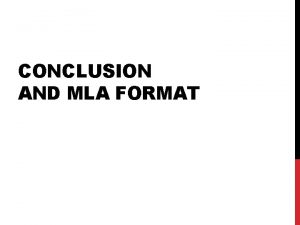Art and Politics CONCLUSION Aesthetics as a Guiding

























- Slides: 25

Art and Politics CONCLUSION

Aesthetics as a Guiding Principle �The relation of art and politics examined from the point of view of aesthetics �Aesthetics provides vocabulary and theoretical frame for understanding the relation of art and politics, contribution of art to politics and the borderline between art and politics �Art understood aesthetically can maintain its independence and its own value => political significance of art gained by aesthetic means (i. e. art need not be propaganda or have a political content, to by significant)

What Is the Aesthetic? �How is the aesthetic defined? What does it say about art? In what sense can the aesthetic and art have political significance? �Line of thought from the end of 18 th – beginning of 19 th century

Schiller and Romantics �Beauty as cultivation of morality and humanity �Ability of art to reconcile sensuality and reason �Freedom experienced in the aesthetic encounter with art opposed to the un-freedom of the actual political state - ideas on the aesthetic and art closely connected with political critique - the aesthetic experience of art as a redemption of society, means of a real political change and new political regime


Ideology �Three ways of understanding ideology: 1. Descriptive meaning - set of ideas, perspectives, attitudes, rituals, values of a certain community, social practices, including nondiscursive (behavior, gestures) - ideology as a worldview 2. Pejorative meaning - false conciousness => interests of a certain group are presented as interests of the society as a whole - justification or legitimization of institutions or social practices, disguise of social contradictions

3. Positive meaning - necessary for coherence of society - Inevitable part of social life and social practices


Critical Theory �Oppresive character of modern (capitalist) societies �Critique of culture industry (Adorno) - mass mediated art is subject to the same economic processes as other commodities => the main purpose is to be sold with as much profit as possible - mass art duplicates rather than challenges social reality - culture industry is ideological => it reinforces the political system and helps to conceal the inequalities in society


The Affirmative Character of Culture �Herbert Marcuse �Culture as a sphere seemingly equally available to everyone, but in fact only reflect the social inequalities �Preservation of the ideal of happiness, hope, emancipation, freedom �Emancipation and happiness in the sphere of art mutes the need of emancipation and happiness in the social sphere �Culture and art contributes to the social un-freedom and coercion by „affirmating“ the status quo

Ai Wei: The Law of the Journey

Aura and Technology �Walter Benjamin, The Work of Art in the Age of Mechanical Reproduction �Positive view of modern technologies and popular, mass culture – mainly film and photography �Change in perception of the world �Technology not as a tool of control over nature, but as a medium of establishing the relation of nature and human �Influence on a huge number of people – political impact of mass art �Aura – mode of reception of the (traditional) artwork with its authority of the „here and now“

Adorno‘s Aesthetic Theory �Artworks are free and autonomous objects in the world where nothing and no one is free and autonomous �Autonomy of art is at the same time enabled by historical and social conditions �Specific character of art determined by the aesthetic synthesis, i. e. the non-violent unity of elements, preserving their particularity and contradictions amongst them

�Social and political significance of art - disclosure of the oppresive, violent character of the social order - art is a rare glimpse of reconciliation and prefigures a reconciled society - art can have only indirect and mediated effect on the social reality - art has a power to intervene in the conciousness of the recipient

Pablo Picasso: Guernica

The Aesthetic Judgment �Roots of general understanding of judgment in the aesthetic judgment - attitude of subject towards the object, which is either positive or negative - distinction of value - we expect others to agree with our judgments, including aesthetic judgments

Political Significance of Aesthetic Judgment in Hannah Arendt‘s Conception �What is necessary for good judgment (based on the - - aesthetic judgment) we imagine the attitudes of others and supress our personal interests => the enlargment of our limited perspective enables a better, more just judgment we perceive, reflect and judge from distance we do not participate in action necessity of distance, detachment, disinterestedness such judgment can be impartial

Damien Hirst: Love's Paradox (2007)

Jacques Rancière �Three Regimes of „Art“/Images 1. The Ethical Regime - not art in our, modern sense - artistic representations judged by their truthfulness and ethical import 2. The Representative Regime - special sphere of imitating representations - norms for discerning good imitations from bad ones - representations governed by rules, hierarchy

3. The Aesthetic Regime - 18 th century (romanticism, realism) - unity of concious and unconcious, acting and passivity, intentional and unintentional - everything can be equally representable, no means of representation are more or less adequate - no boundaries between art and non-art, between high art and the ordinary objects - re-interpretation of art, including art of the past

The Distribution of the Sensible �aesthetic act of reconfiguration of what is available to the senses �political act by the abolition of the fixed hierarchy and power relations based on determing who can (and cannot) act or perceive �politics suggests the re-distribution of the sensible, i. e. of what is visible, represented in society => the aesthetic dimension of politics as collapse of the regulative laws of representation �political dimension of art => artwork (in aesthetic regime) is a singular perspective, intervention into the configurations of the sensible

Taryn Simon: The Picture Collection

Taryn Simon: Contraband

 Hegel three forms of art
Hegel three forms of art Beast and beauty aesthetics
Beast and beauty aesthetics Gestalt approach
Gestalt approach Racquel aesthetics
Racquel aesthetics Physio pleasure examples
Physio pleasure examples The concept of aesthetics
The concept of aesthetics Mechanics dynamics aesthetics examples
Mechanics dynamics aesthetics examples The aesthetics studio
The aesthetics studio Platos aesthetics
Platos aesthetics Nicolas bourriaud relational aesthetics
Nicolas bourriaud relational aesthetics Transcendental aesthetic kant
Transcendental aesthetic kant Environmental aesthetics
Environmental aesthetics Photography definition in art
Photography definition in art Hume aesthetics
Hume aesthetics Biotechnology aesthetics
Biotechnology aesthetics Introduction to aesthetics
Introduction to aesthetics Applied media aesthetics
Applied media aesthetics Mechanics dynamics aesthetics
Mechanics dynamics aesthetics Point of view aesthetic
Point of view aesthetic Aesthetics developers
Aesthetics developers Nuffield aesthetics singapore
Nuffield aesthetics singapore Film aesthetics
Film aesthetics Gk aesthetics
Gk aesthetics Banobagi plastic surgery & aesthetics
Banobagi plastic surgery & aesthetics Guiding principles for teaching and learning in mtb-mle
Guiding principles for teaching and learning in mtb-mle Guiding play and puppetry experiences
Guiding play and puppetry experiences

